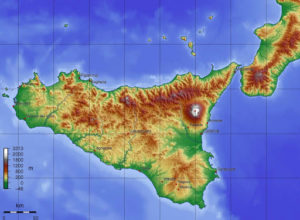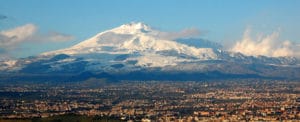
The terrain of inland Sicily is mostly hilly and is intensively cultivated wherever possible. Along the northern coast, the mountain ranges of Madonie, 2,000 m (6,600 ft), Nebrodi, 1,800 m (5,900 ft), and Peloritani, 1,300 m (4,300 ft), are an extension of the mainland Apennines. The cone of Mount Etna dominates the eastern coast. In the southeast lie the lower Hyblaean Mountains, 1,000 m (3,300 ft). The mines of the Enna and Caltanissetta districts were part of a leading sulfur-producing area throughout the 19th century, but have declined since the 1950s.
Sicily and its surrounding small islands have some highly active volcanoes. Mount Etna is the largest active volcano in Europe and still casts black ash over the island with its ever-present eruptions. It currently stands 3,329 metres (10,922 ft) high, though this varies with summit eruptions; the mountain is 21 m (69 ft) lower now than it was in 1981. It is the highest mountain in Italy south of the Alps. Etna covers an area of 1,190 km2 (459 sq mi) with a basal circumference of 140 km (87 mi). This makes it by far the largest of the three active volcanoes in Italy, being about two and a half times the height of the next largest, Mount Vesuvius. In Greek mythology, the deadly monster Typhon was trapped under the mountain by Zeus, the god of the sky. Mount Etna is widely regarded as a cultural symbol and icon of Sicily.

The Aeolian Islands in the Tyrrhenian Sea, to the northeast of mainland Sicily form a volcanic complex, and include Stromboli. The three volcanoes of Vulcano, Vulcanello and Lipari are also currently active, although the latter is usually dormant. Off the southern coast of Sicily, the underwater volcano of Ferdinandea, which is part of the larger Empedocles volcano, last erupted in 1831. It is located between the coast of Agrigento and the island of Pantelleria (which itself is a dormant volcano).
The autonomous region also includes several neighboring islands: the Aegadian Islands, the Aeolian Islands, Pantelleria and Lampedusa.
Economy:
Thanks to the regular growth of the last years, Sicily is the eighth largest regional economy of Italy in terms of total GDP. A series of reforms and investments in agriculture such as the introduction of modern irrigation systems have made this important industry competitive. In the 1970s there was a growth of the industrial sector through the creation of some factories. In recent years the importance of the service industry has grown for the opening of several shopping malls and for modest growth of financial and telecommunication activities. Tourism is an important source of wealth for the island thanks to its natural and historical heritage. Today Sicily is investing a large amount of money on structures of the hospitality industry, in order to make tourism more competitive. However, Sicily continues to have a GDP per capita below the Italian average and higher unemployment than the rest of Italy.
